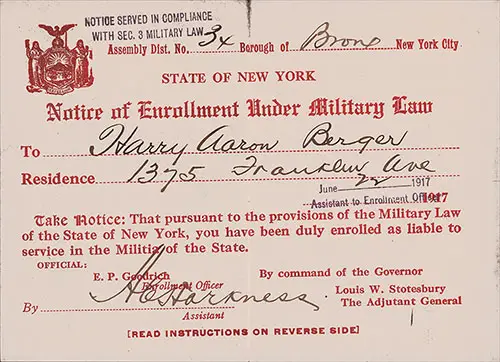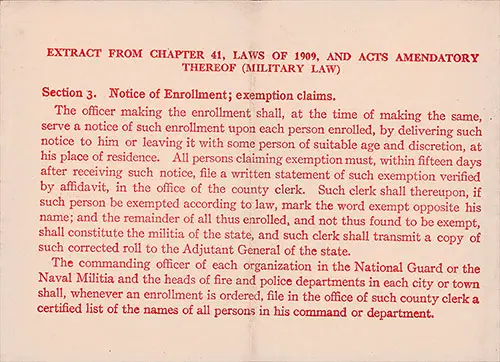State of New York Notice of Enrollment Under Military Law - 1917-06-22

Front Side, State of New York, Notice of Enrollment Under Military Law for Harry Aaron Berger of Bronx, New York City, Dated 22 June 1917. GGA Image ID # 182298a120
NOTICE SERVED IN COMPLIANCE WITH SEC. 3 MILITARY LAW
Assembly Dist. No. 3x Borough of Bronx New York City
STATE OF NEW YORK
Notice of Enrollment Under Military Law
To Harry Aaron Berger
Residence 1375 Franklin Ave
June 22 1917
Assistant to Enrollment Officer
Take Notice: That pursuant to the provisions of the Military Law of the State of New York, you have been duly enrolled as liable to service in the Militia of the State.
OFFICIAL: E. P. Goodrich, Enrollment Officer by /s/ Alestarnness Assistant
By command of the Governor Louis W. Stotesbury, The Adjutant General
[READ INSTRUCTIONS ON REVERSE SIDE]

Back Side, State of New York, Notice of Enrollment Under Military Law for Harry Aaron Berger of Bronx, New York City, Dated 22 June 1917. Extract from Chapter 41, Laws of 1909 and Acts Amendatory Thereof (Military Law). GGA Image ID # 1822ca2148
Extract From Chapter 41, Laws of 1909, and Acts Amendatory Thereof (Military Law)
Section 3. Notice of Enrollment; exemption claims.
The officer making the enrollment shall, at the time of making the same, serve a notice of such enrollment upon each person enrolled, by delivering such notice to him or leaving it with some person of suitable age and discretion, at his place of residence.
All persons claiming exemption must, within fifteen days after receiving such notice, file a written statement of such exemption verified by affidavit, in the office of the county clerk.
Such clerk shall thereupon, if such person be exempted according to law, mark the word exempt opposite his name; and the remainder of all thus enrolled, and not thus found to be exempt, shall constitute the militia of the state, and such clerk shall transmit a copy of such corrected roll to the Adjutant General of the state.
The commanding officer of each organization in the National Guard or the Naval Militia and the heads of fire and police departments in each city or town shall, whenever an enrollment is ordered, file in the office of such county clerk a certified list of the names of all persons in his command or department.
Confusion as to requirements of State Military Law
The Military Census was two fold. First, there was the enumerating and inventory that applied to everybody within the State between the ages of 16 and 50, and second, there were the provisions of the Militia Enrollment Law.
The State Military Law requires that a special notice of enrollment be served on each person enrolled under its provisions in the State militia.
It had been decided that all male citizens and aliens who had taken out their first papers of application for admission to citizenship should be enrolled in the militia at the time they appeared before the registrar to answer the questions for the census and inventory.
Special notification blanks were printed and the registrars were instructed to serve them personally upon all eligible males. They were instructed also to make a note of the service upon the registration form and subscribe their names as enrollment officers, with the date of service, and rubber stamps were supplied to facilitate the process.
Enrollment Forms Printed in Red Ink
The militia enrollment forms were printed in red ink. On the back, they carried a section of the law that stated that all persons who claim exemption from service in the militia must file an affidavit stating the reasons for the exemption claim with the county clerk of the county they resided in.
This led to much confusion in New York City. Thousands of men, most of them aliens, who had not yet completed their naturalization, hurried to the county clerks in the five counties comprising Greater New York to claim exemption.
The claims included the lame, the halt, the blind, as well as newly married men and men with families of dependents.
The county clerks in some counties received the claims and filed them. Long lines of men were gathered daily in front of the county clerks' offices for several days, and many arguments and considerable interference with the county clerks' work resulted.
Finally, an order was received from the State authorities at Albany instructing all census officers and registrars to instruct the man served with the "militia enrollment notice" that they were not required to file their claims for exemption with the county clerk.
The Attorney-General gave this opinion since after the Census had started the United States, Congress passed a law including the State Militia in the Federal Militia, thus changing the exemption clauses from State to Federal status.
"Confusion as to Requirements of State Military Law," in The New York State Military Census and Inventory: A Report to Hon. Charles S. Whitman, Governor of the State of New York, 1917, Albany: J. B. Lyon Company, pp. 59-60.
